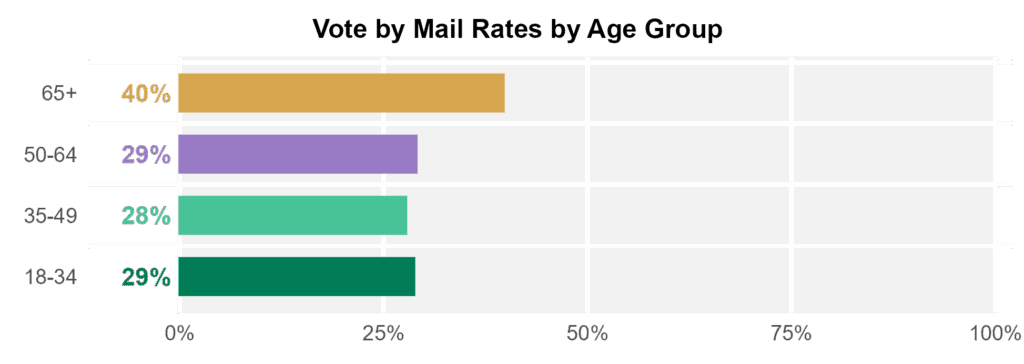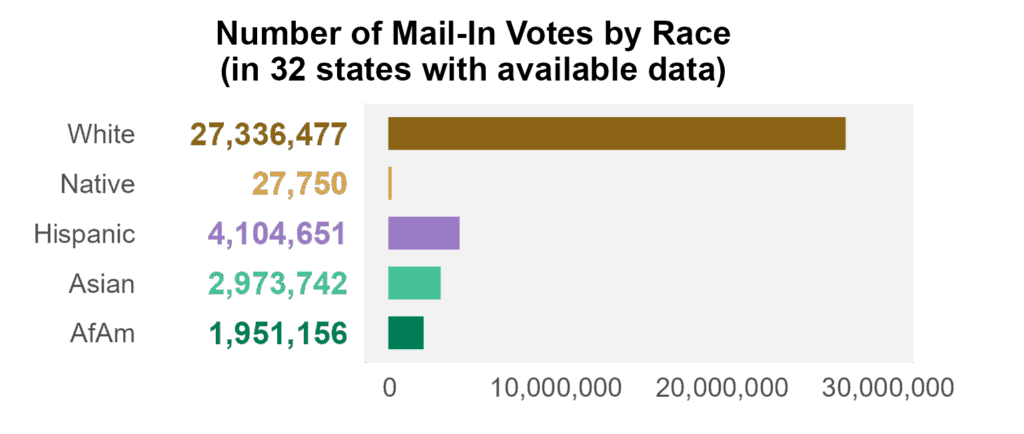Nearly 1 in 3 Americans Voted by Mail in 2024
States United analysis reveals that white voters, voters 65+, and overseas U.S. military voters are among the groups that relied significantly on voting by mail in the last presidential election.
When Americans exercise their right to vote, they have the option to cast their ballot in a variety of ways according to the laws of their state. Voting by mail is one of the most widely used and trusted methods of voting, offered by every state in the country in some form. Voting by mail is a secure and reliable way that U.S. citizens make their voices heard.
On August 18th, President Trump pledged to “get rid of mail-in ballots” entirely—something he does not have the authority to do. The U.S. Constitution gives states the power to decide how to run elections, including setting their policies for different voting methods based on what works for their communities.
States United sought to understand the use of vote-by-mail today in the states and the potential impact if it were not an option for voters. We examined the verified voting records of the 2024 general election and looked at the demographic breakdown of how Americans used this method of voting.
The results are clear: tens of millions of Americans—of all backgrounds and regions of the country—vote by mail to participate in our democracy.
- Nearly 1 in 3 Americans (31%) voted by mail in the 2024 general election, accounting for more than 48 million votes.
- People of all demographics used vote-by-mail. Some used it more than others:
- Age: Voters ages 65+ were most likely to use mail-in voting. Mailed ballots accounted for almost 40% of votes cast by this group.
- Race: 1 in 3 white voters cast ballots by mail in 2024, totaling over 27 million votes. White voters cast the greatest number of mail-in ballots of all racial demographic groups.
- Urbanicity: Voters in every geographic setting used mail-in ballots at high rates. Mailed ballots were cast by 1 in 3 suburban voters, 1 in 3 city voters, and 1 in 4 rural voters.
- Abroad: Hundreds of thousands of members of the U.S. military and U.S. citizens living abroad relied on mail-in ballots to cast their vote in 2024, sending 905,343 votes through the mail. Alabama and Florida were the states that received the largest number of mail-in ballots from U.S. citizens living and serving abroad.
- Party: Voters of every political affiliation cast ballots by mail in 2024. Both President Trump and Vice President Harris won multiple states where the majority of ballots were cast by mail.
- About 1 in 4 Democrats and 1 in 5 Republicans voted by mail, as well as 1 in 5 voters who registered with other parties or with no party.
- More than 1 in 3 Republicans voted by mail in five states and Washington, D.C. (CO, CA, WY, ME, NV, and DC).
- More than 1 in 3 Democrats voted by mail in seven states and Washington D.C. (CO, CA, WY, ME, NV, IA, and DC).
Note: these demographic findings are based on 32 states with available data. The analysis reflects vote type data for 113,841,164 voters out of the total 156,766,239 voters who cast ballots in the 2024 general election, or roughly 72% of all votes cast.
See Methodology for more details.
For every age group, at least 1 in 4 voters cast a ballot by mail in 2024. Voters ages 65+ were the most likely to vote by mail. These voters cast nearly 40% of their votes by mail.

Race: White voters were the largest group of voters to cast votes by mail in 2024. About 1 in 3 white voters voted by mail, accounting for over 27 million votes in the states analyzed.

Americans chose to vote by mail in every type of geographical setting in the country. Nearly 1 in 4 rural voters, roughly 1 in 3 suburban voters, and just over 1 in 3 urban voters cast their ballot by mail.

Hundreds of thousands of members of the U.S. military and U.S. citizens living abroad relied on mail-in ballots in 2024. Often referred to as UOCAVA voters (Uniformed and Overseas Citizens Absentee Voting Act), these citizens accounted for 905,343 ballots cast in 2024, according to the 2024 Election Administration and Voting Survey (EAVS) Comprehensive Report.
The states with the largest number of ballots cast by members of the U.S. military and U.S. citizens abroad were Alabama (131,961), Florida (92,268), and California (82,549).
To assess mail voting trends by political affiliation, we looked at available data from 10 states with closed primaries, where voters are required to register by party if they want to vote in a primary. (See Methodology for full list of states).
Mail-in voting was popular among registered voters across all parties in 2024. It was a voting option used by about 1 in 4 Democrats, 1 in 5 Republicans, and 1 in 5 voters registered to other parties.
In five states and Washington D.C., more than 1 in 3 Republicans voted by mail (CO, CA, DC, WY, ME, NV).
In seven states and Washington D.C., more than 1 in 3 Democrats voted by mail (CO, CA, DC, WY, ME, NV, IA).

Each state sets its own laws about voting by mail. As a result, usage of vote-by-mail varies by state.
Some states conduct their elections primarily by mail. Concentrated in the Western part of the country, these states allow no-excuse absentee voting: California, Colorado, Hawaii, Nevada, Oregon, Utah, Vermont, and Washington. All of these states, except OR and WA, also allow anyone the option to vote in person if they prefer. In OR and WA, there is no in-person voting. However, if voters need assistance with mail ballots they can go to certain voting offices for help.
On the other hand, several states offer more limited options for voting by mail and see far fewer ballots cast by mail as a result. Concentrated in the South and substantial portions of the Northeast, states that require a specific excuse for mail-in voting (such as being sick, over the age 65, or out of the county during an election) include: Alabama, Arkansas, Connecticut, Delaware, Indiana, Kentucky, Louisiana, Mississippi, Missouri, New Hampshire, South Carolina, Tennessee, Texas, and West Virginia.
The majority of state vote-by-mail and general turnout data was obtained through EAVS Data. In states where in-person or vote-by-mail data was incomplete (Alabama, Connecticut, Iowa, Mississippi, Montana, New Jersey, and Oregon), we included state-specific Secretary of State voting data. The links to those state-specific totals can be found below:
- Alabama: Comprehensive Voter Turnout 1986-2024
- Connecticut: 2024 Statement of Vote
- Iowa: REPORT OF VOTERS REGISTERED AND VOTING
- Mississippi: Certification of Vote for Electors for President and Vice President and 2024 November General Election Absentee Report (November 4)
- Montana: 2024 Montana General Election Absentee Ballot Counts and Statewide Voter Turnout
- New Jersey: Total Number of Registered Voters, Ballots Cast, Ballots Rejected, Percentage of Ballots Cast and the Total Number of Election Districts in New Jersey
- Oregon: STATISTICAL SUMMARY November 5, 2024, GENERAL ELECTION
Demographic data was obtained through TargetSmart voter file, accessed via CIVIS.
The table below provides the raw numbers on which the demographic charts are based: total numbers of those who voted from each demographic group and the numbers who voted by mail.
The following states are excluded from the demographic analysis because our voter file does not have any vote type data for them: AL, DE, IL, KS, KY, LA, MA, MI, MO, MS, ND, NE, OH, OR, SC, SD, UT, VT.
For the party-based demographic analysis, we examined states with closed primaries that require voters to register by party to vote in primary elections. Fifteen states total have closed primaries: CT, DE, FL, KY, ME, MD, NV, NY, OK, OR, PA, SD, UT, DC, WY. Of these states, our analysis reflects ten of them, because five of these states did not have vote type data in the voter file. The five closed-primary states not reflected in this demographic analysis are: DE, KY, OR, SD, and UT.
